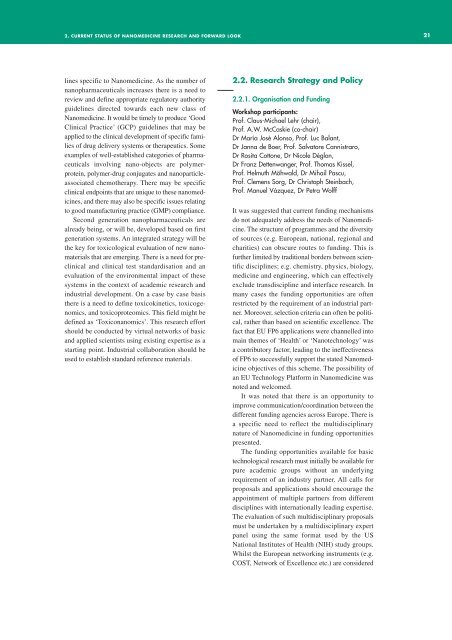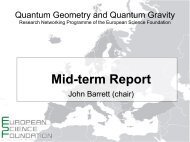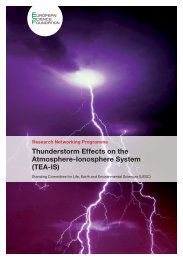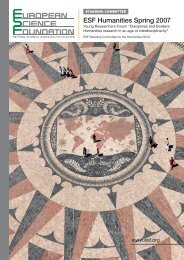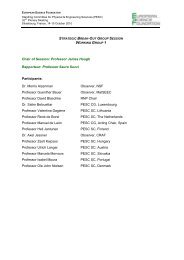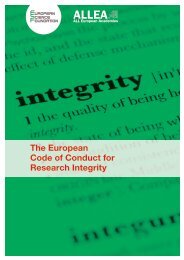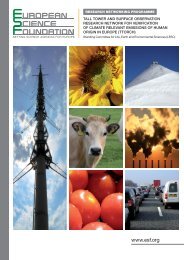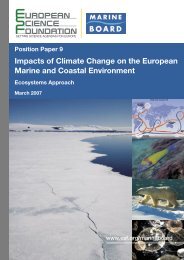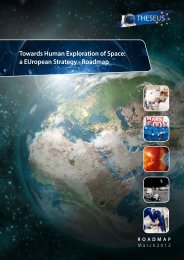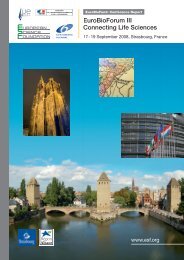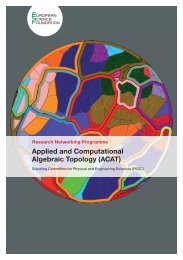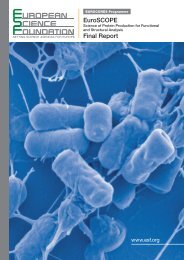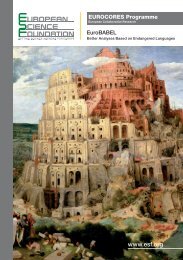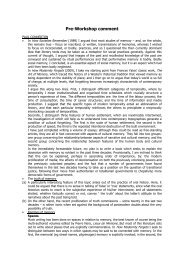Nanomedicine - European Science Foundation
Nanomedicine - European Science Foundation
Nanomedicine - European Science Foundation
You also want an ePaper? Increase the reach of your titles
YUMPU automatically turns print PDFs into web optimized ePapers that Google loves.
2. CURRENT STATUS OF NANOMEDICINE RESEARCH AND FORWARD LOOK 21<br />
lines specific to <strong>Nanomedicine</strong>. As the number of<br />
nanopharmaceuticals increases there is a need to<br />
review and define appropriate regulatory authority<br />
guidelines directed towards each new class of<br />
<strong>Nanomedicine</strong>. It would be timely to produce ‘Good<br />
Clinical Practice’ (GCP) guidelines that may be<br />
applied to the clinical development of specific families<br />
of drug delivery systems or therapeutics. Some<br />
examples of well-established categories of pharmaceuticals<br />
involving nano-objects are polymerprotein,<br />
polymer-drug conjugates and nanoparticleassociated<br />
chemotherapy. There may be specific<br />
clinical endpoints that are unique to these nanomedicines,<br />
and there may also be specific issues relating<br />
to good manufacturing practice (GMP) compliance.<br />
Second generation nanopharmaceuticals are<br />
already being, or will be, developed based on first<br />
generation systems. An integrated strategy will be<br />
the key for toxicological evaluation of new nanomaterials<br />
that are emerging. There is a need for preclinical<br />
and clinical test standardisation and an<br />
evaluation of the environmental impact of these<br />
systems in the context of academic research and<br />
industrial development. On a case by case basis<br />
there is a need to define toxicokinetics, toxicogenomics,<br />
and toxicoproteomics. This field might be<br />
defined as ‘Toxiconanomics’. This research effort<br />
should be conducted by virtual networks of basic<br />
and applied scientists using existing expertise as a<br />
starting point. Industrial collaboration should be<br />
used to establish standard reference materials.<br />
2.2. Research Strategy and Policy<br />
2.2.1. Organisation and Funding<br />
Workshop participants:<br />
Prof. Claus-Michael Lehr (chair),<br />
Prof. A.W. McCaskie (co-chair)<br />
Dr María José Alonso, Prof. Luc Balant,<br />
Dr Janna de Boer, Prof. Salvatore Cannistraro,<br />
Dr Rosita Cottone, Dr Nicole Déglon,<br />
Dr Franz Dettenwanger, Prof. Thomas Kissel,<br />
Prof. Helmuth Möhwald, Dr Mihail Pascu,<br />
Prof. Clemens Sorg, Dr Christoph Steinbach,<br />
Prof. Manuel Vázquez, Dr Petra Wolff<br />
It was suggested that current funding mechanisms<br />
do not adequately address the needs of <strong>Nanomedicine</strong>.<br />
The structure of programmes and the diversity<br />
of sources (e.g. <strong>European</strong>, national, regional and<br />
charities) can obscure routes to funding. This is<br />
further limited by traditional borders between scientific<br />
disciplines; e.g. chemistry, physics, biology,<br />
medicine and engineering, which can effectively<br />
exclude transdiscipline and interface research. In<br />
many cases the funding opportunities are often<br />
restricted by the requirement of an industrial partner.<br />
Moreover, selection criteria can often be political,<br />
rather than based on scientific excellence. The<br />
fact that EU FP6 applications were channelled into<br />
main themes of ‘Health’ or ‘Nanotechnology’ was<br />
a contributory factor, leading to the ineffectiveness<br />
of FP6 to successfully support the stated <strong>Nanomedicine</strong><br />
objectives of this scheme. The possibility of<br />
an EU Technology Platform in <strong>Nanomedicine</strong> was<br />
noted and welcomed.<br />
It was noted that there is an opportunity to<br />
improve communication/coordination between the<br />
different funding agencies across Europe. There is<br />
a specific need to reflect the multidisciplinary<br />
nature of <strong>Nanomedicine</strong> in funding opportunities<br />
presented.<br />
The funding opportunities available for basic<br />
technological research must initially be available for<br />
pure academic groups without an underlying<br />
requirement of an industry partner. All calls for<br />
proposals and applications should encourage the<br />
appointment of multiple partners from different<br />
disciplines with internationally leading expertise.<br />
The evaluation of such multidisciplinary proposals<br />
must be undertaken by a multidisciplinary expert<br />
panel using the same format used by the US<br />
National Institutes of Health (NIH) study groups.<br />
Whilst the <strong>European</strong> networking instruments (e.g.<br />
COST, Network of Excellence etc.) are considered


